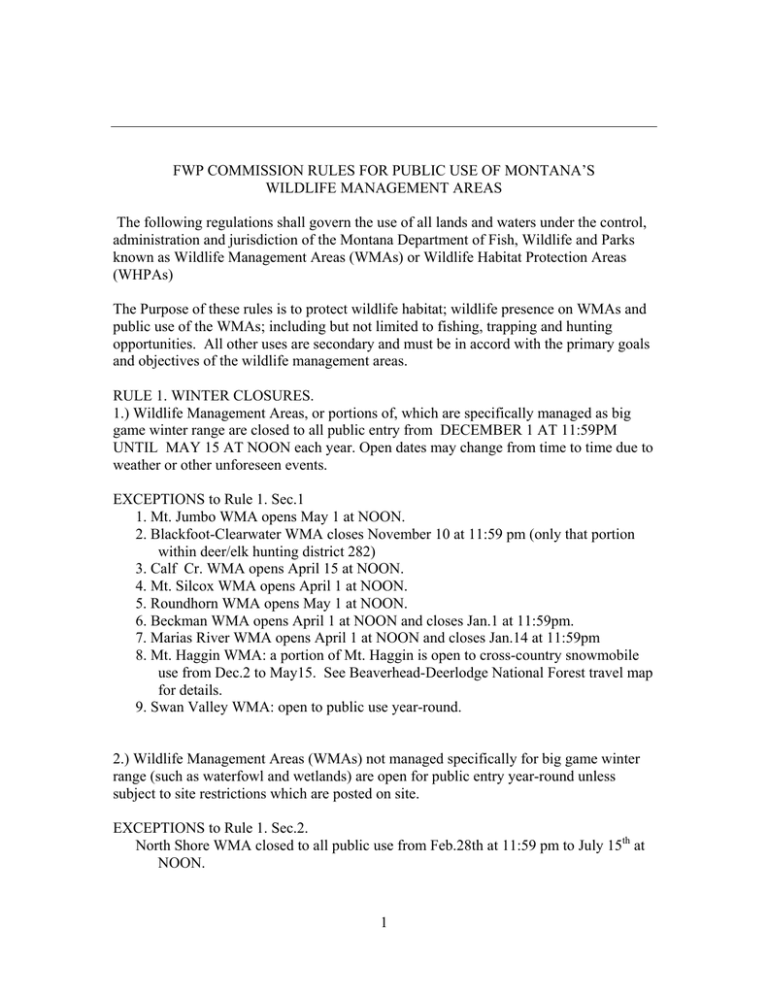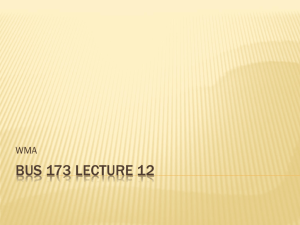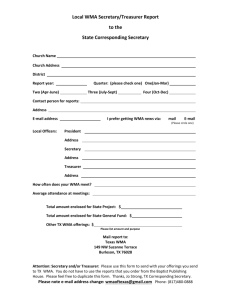1 FWP COMMISSION RULES FOR PUBLIC USE OF MONTANA`S
advertisement

FWP COMMISSION RULES FOR PUBLIC USE OF MONTANA’S WILDLIFE MANAGEMENT AREAS The following regulations shall govern the use of all lands and waters under the control, administration and jurisdiction of the Montana Department of Fish, Wildlife and Parks known as Wildlife Management Areas (WMAs) or Wildlife Habitat Protection Areas (WHPAs) The Purpose of these rules is to protect wildlife habitat; wildlife presence on WMAs and public use of the WMAs; including but not limited to fishing, trapping and hunting opportunities. All other uses are secondary and must be in accord with the primary goals and objectives of the wildlife management areas. RULE 1. WINTER CLOSURES. 1.) Wildlife Management Areas, or portions of, which are specifically managed as big game winter range are closed to all public entry from DECEMBER 1 AT 11:59PM UNTIL MAY 15 AT NOON each year. Open dates may change from time to time due to weather or other unforeseen events. EXCEPTIONS to Rule 1. Sec.1 1. Mt. Jumbo WMA opens May 1 at NOON. 2. Blackfoot-Clearwater WMA closes November 10 at 11:59 pm (only that portion within deer/elk hunting district 282) 3. Calf Cr. WMA opens April 15 at NOON. 4. Mt. Silcox WMA opens April 1 at NOON. 5. Roundhorn WMA opens May 1 at NOON. 6. Beckman WMA opens April 1 at NOON and closes Jan.1 at 11:59pm. 7. Marias River WMA opens April 1 at NOON and closes Jan.14 at 11:59pm 8. Mt. Haggin WMA: a portion of Mt. Haggin is open to cross-country snowmobile use from Dec.2 to May15. See Beaverhead-Deerlodge National Forest travel map for details. 9. Swan Valley WMA: open to public use year-round. 2.) Wildlife Management Areas (WMAs) not managed specifically for big game winter range (such as waterfowl and wetlands) are open for public entry year-round unless subject to site restrictions which are posted on site. EXCEPTIONS to Rule 1. Sec.2. North Shore WMA closed to all public use from Feb.28th at 11:59 pm to July 15th at NOON. 1 RULE 2. HUNTING & TRAPPING SEASONS. 1.) Wildlife Management Areas are open to all FWP Commission established hunting seasons unless closed under Rule 1 or specifically closed or restricted as noted in Hunting Regulations. Closure or restriction notices shall be posted at entrance points and parking areas. 2.) Wildlife Management Areas are open to trapping unless closed under Rule 1 or specifically allowed, closed, or restricted as noted in trapping regulations. Trapping on WMAs will be allowed by written permission only. Permission to trap on WMAs may require special restrictions or regulations in addition to what is written in the SPECIAL REGULATIONS. Contact the area biologist, WMA manager or appropriate regional office. 3.) FWP Commission authorizes the department to issue WMA specific restrictions. RULE 3. GROUP USE. 1.) Groups of 10 or more persons are required to obtain a Group Use Permit from the wildlife area (WMA) manager or regional office responsible for the WMA to be used; must follow group use instructions; shall be assessed user fees and shall be required to surrender a deposit to defray costs caused by their use of the WMA. 2.) A group of 10 or more persons may be allowed to use a WMA if group activities and purpose do not conflict with objectives and management purposes of the WMA. 3.) If group use is part of or for a commercial use, a commercial use permit must be obtained. See Rule 10. RULE 4. VEHICLE USE. 1.)Properly licensed vehicles allowed only on designated open roads . Snowmobiles allowed on groomed trails. EXCEPTIONS to Rule 4. Sec. 1. 1. Yellowstone WMA: vehicles, bicycles, snowmobiles, horses and pack animals are only allowed on roads designated as “open.” 2. Marshall Creek WMA: Snowmobiling will be allowed throughout the WMA, but is restricted to designated open roads April 1 – November 30. 3. Fish Creek WMA: Snowmobiling is not allowed within the winter closure area during the closed period. Snowmobiling is allowed throughout the remainder of the WMA, but is restricted to designated open roads April 1-November 30. 2.)Off road travel with any motor/engine powered wheeled vehicle is prohibited. 3.)If an entire WMA is closed to vehicle use, this rule shall be posted on a sign at all access points to the WMA. 2 RULE 5. CAMPING. 1.) Dispersed camping is allowed unless posted otherwise. Vehicles shall be no more than 50 yards from an open road. 2.) Camping is limited to 16 days in any 30 day period. EXCEPTIONS to Rule 5. Sec. 2 1. Region One: no camping or overnight stays on WMAs, which include Bighorn Viewing Site WMA; Buffalo Head Park WHPA; Bull Rive WMA; Flathead Lake WHPA; Flathead River WHPA; Big Spruce WHPA; Leisure Island WHPA; Pressentine WHPA; Horseshoe Lake WHPA; Kootenai Falls WMA; Kootenai West WMA; Kootenai Woods Ranch WMA; Lower Stillwater Lake WHPA; Mount Silcox WMA; Ninepipe WMA; North Swan Valley WMA; Pablo WMA; Ray Kuhns WMA; Roundhorn WMA; Swan Lake WHPA; Wild Drake Island WHPA. 2. Region Three: no camping or overnight stays on Lake Helena WMA; Canyon Creek WMA. 3. Region Five: no camping or overnight stays on Yellowstone WMA 4. Region Seven: camping limited to 7 days within a 30 day period. Daily occupancy is required. RULE 6. WATERCRAFT. All wildlife management area waters are open to watercraft unless an exception is posted to close the area or restrict the size of watercraft, horsepower of engine or season of use . Closure or restriction notice shall be posted at entrance points and parking areas. RULE 7. WEED FREE FEED. Only pelletized feed or certified weed seed free hay, straw, or whole grains and cube products are authorized for use on wildlife management areas. Each bale or container of forage shall have attached a tag or label or be marked with authorized colored twine referencing the written certification. RULE 8. ANIMAL CONTROL. 1.) Persons in possession of pets and domestic animals shall restrain them and keep them under control in a manner that does not cause or permit a nuisance or danger to persons, property or wildlife. This shall not preclude using dogs for hunting during legally open hunting seasons. EXCEPTIONS to Rule 8. Sec. 1. 1. On the Kootenai Falls WMA all dogs must be physically restrained at all times by a leash held by the person responsible for the animal. This is necessary due to the presence of bighorn sheep. 2. North Shore WMA: Pets must remain on leash at all times except during upland and migratory bird hunting seasons. 3. Canyon Ferry WMA: Pets must remain on leash March 1 to June 30. 4. Lake Helena, Ninepipe and Pablo WMAs: Pets must remain on leash April 1 to Aug.31. 3 2.) All domesticated pack or riding stock, not in use, must be tethered or corralled. 3.) Animal owners shall be aware that activities such as trapping, hunting and fishing are occurring on WMAs during legally authorized seasons and shall be responsible for taking precautions. RULE 9. DOG TRAINING. Organized dog training, field trials and hunt tests are prohibited on all wildlife management areas except as authorized by regional wildlife manager. RULE 10. COMMERCIAL USE. Commercial use is regulated by the F.W.P. COMMERCIAL USE POLICY. RULE 11. FIREWOOD. 1.)Cutting standing trees and shrubs is prohibited, unless specifically authorized by FWP advertisement, sign posting or permits. 2.) Downed wood for onsite use is permitted. 3.)Gathering firewood for offsite use is prohibited, unless specifically authorized by FWP advertisement, sign posting or permits. EXCEPTIONS to Rule 11. Sec. 3. Marshall Creek WMA: personal use firewood collection permits may be obtained by contacting R2 (Missoula) office. RULE 12. FIRES. Fires are allowed in portable camp stoves, fireplaces and self made fire rings, unless otherwise prohibited by emergency fire restrictions. EXCEPTIONS to Rule 12. 1. Kootenai Falls WMA: no open fires above high water mark. 2. Ninepipe and Pablo WMAs: no open fire allowed. 3. Lake Helena: no open fire allowed. 4. Yellowstone WMA: no open fire allowed. RULE 13. WEAPONS. 1.)Weapons discharge only allowed for lawful hunting purposes or target shooting at shooting ranges authorized by FWP. For the purposes of these rules, weapons are defined as instruments that discharge a high velocity projectile, used for hunting, selfprotection, and recreation, including but not limited to firearms and bow and arrow. k2.)Discharge of paint ball guns is prohibited. RULE 14. FIREWORKS. Discharge of fireworks is prohibited on all wildlife management areas. RULE 15. SIGNS. Unauthorized signs are prohibited. (MCA 45-6-101(5) and MCA 87-1-102(2)(e) 4 RULE 16. FOOD STORAGE. Bear resistant food storage required on following WMAs per Food Storage Order (attached) R1 All WMAs R2 All WMAs R3 Mt. Haggin Bear Cr. Canyon Cr. Wall Cr. Blacktail Robb/Ledford Gallatin Fleecer Mtn. Dome Mtn. R4 Blackleaf Ear Mtn. Marias River Sun River R5 Silver Run Haymaker RULE 17. SAFETY ZONES. Safety Zones (no shooting zones) designated for the protection of people and property are in force as posted. RULE 18. ANIMAL CARCASSES. Dumping of animal carcasses is prohibited. This does not include boned-out BIG game animal remains legally taken on site. EXCEPTION to Rule 18. For FWP bear management purposes, carcasses may be placed on WMAs by authorized FWP personnel and the area will be signed that animal carcasses are present. RULE 19. HUNTING BLINDS, TREE STANDS, GOOSE PITS. 5 1.)Hunting blinds, tree stands and goose pits left overnight does not guarantee exclusive use. 2.)Hunting blinds, tree stands and goose pits must be removed at season closure. 3.)Permanent blinds, tree stands and goose pits are prohibited. RULE 20. REMOVAL OF NATURAL RESOURCES. Removal of topsoil, gravel, minerals, cultural or archeological artifacts, and fossils is prohibited. RULE 21. SPECIES TRANSLOCATION Introduction of any plants or animals is prohibited unless authorized by FWP. RULE 22. LITTERING. Littering is prohibited. This includes the dumping of sewage wastes from trailers, campers, or portable toilets. RULE 23. ANTLER COLLECTING. Antler collecting is prohibited on all wildlife management areas when these areas are closed to public use. (MCA 87-1-102(2)(f)) RULE 24. SECONDARY RECREATIONAL ACTIVITIES. Secondary recreational uses of wildlife management areas may be allowed by Regional Wildlife Manager if such use does not conflict with the primary purpose of the WMA. 6 FOOD STORAGE ORDER IT IS REQUIRED THAT IN DESIGNATED FWP WILDLIFE MANAGEMENT AREAS: 1. Human, pet and livestock food (except baled or cubed hay without additives), garbage, and all other attractants shall be stored in an approved bear resistant manner or container when camp is unattended. (see definition of attended below) or during nighttime hours. 2. Wildlife carcasses, birds, fish or other animal parts that are within ¼ mile of any camp or sleeping area shall be stored in an approved bear-resistant manner or container when unattended. If a wildlife carcass is within an attended camp during daytime hours it may be on the ground. 3. Attractants (such as food leftovers or bacon grease) shall not be buried, discarded, or burned in an open campfire. A. Leftover food or food waste products may be placed in an appropriate, sealed container and packed out with garbage. B. Leftover food or other attractants may be burned in a contained stove fire C. Attractants may be placed into a suitable container (i.e. tin can) to prevent leaching into the ground and burned over an open campfire. Any remaining attractants unconsumed by burning shall be placed with other garbage and packed out. 4. The responsible party for any dead pack animal or livestock shall report the death and location of any livestock to a FWP employee within 24 hours of discovery. The responsible party will be required to dispose of the carcass as directed by the regional wildlife manager. In some very remote areas, it may not be possible to meet the 24-hour requirement. In these special cases, the responsible party shall report to a FWP employee the discovery of any dead livestock within 48 hours. 5. Bear-resistant containers must meet the following criteria: a securable container constructed of solid material capable of withstanding 200 footpounds of energy applied by direct impact. The container, when secured and under stress, will not have any openings greater than 1/4 inch, that would allow a bear to gain entry by biting or pulling with its claws. 7 Testing and approval programs are available through the US Forest Service. Other bear-resistant containers developed for personal use may be inspected for approval by the local FWP game warden or WMA Area Manager or their designated representative(s). DEFINITIONS 1. Attended: At least one adult person (attendee) is physically present within 100 feet of, and can visually observe attractants at all times. Attended camp policy does not apply when campers are asleep or do not have visual contact with and physical control of the attractants. During nighttime hours, control is defined by having the attractant within arm’s reach or secured in an agency approved container or manner. 2. Attractant: Any item potentially attracting and/or rewarding a bear. This shall include: a. b. c. d. e. f. g. food as defined below food leftovers (bones, scraps, grease) garbage from humans livestock foods (except baled or cubed hay without additives) pet foods wildlife carcasses livestock carcasses 3. Food: Any nourishing substance, which includes human food or drink (canned, solid or liquid), livestock feed (except baled or cubed hay without additives), pet food, toothpaste, soap, birdseed, and hummingbird food. 4. Attendee: An adult (14 years of age or older) in control of attractants. 5. Bear-resistant container: A securable container constructed of solid material capable of withstanding 200 foot-pounds of energy applied by direct impact. The container, when secured and under stress, will not have any openings greater than one-quarter (1/4) inch, that would allow a bear to gain entry by biting or pulling with its claws. 6. Bear-resistant manner means the storage of any attractant or foods in one of the following ways: a. b. c. Secured in a hard-sided camper, vehicle trunk, cab or trailer cab. Secured in a hard-sided dwelling or storage building. Suspended at least 10 feet up (from the bottom of the suspended item) and 4 feet out from any upright support, i.e. tree, pole. 8 d. e. f. g. Stored in an agency approved bear-resistant container. Stored within an approved and operating electric fence. (see Definition #12 for details) Stored in any combination of these methods. Or stored by methods other than those described in Section #6, a-f, that shall be approved in writing by the FWP Regional Supervisor. 7. Contained fire stove: a metal stove that completely encloses the fire. 8. Daytime: 1/2-hour before sunrise until 1/2-hour after sunset. 9. Nighttime: 1/2-hour after sunset until 1/2-hour before sunrise. 10. Livestock: Cattle, sheep or a domesticated pack or riding animal, such as mule, horse, llama, or goat. 11. Wildlife carcass: The body, or any parts thereof, of any deceased wild animal, bird, or fish. 12. Approved electric fence will meet, as a minimum: a. b. d. e. g. h. i. The fence will be set up as a “tight wire” fence. The wire will be tight and under tension, not loose or sagging and posts will be firmly installed. Minimum fence height: 40 inches to top wire Maximum spacing between posts: 8 feet. Wire conductors: Minimum of 4 hot wires, evenly spaced with no more than a 10 inch spacing between wires. Bottom hot wire must be within 10 inches of the ground. Top hot wire must be within 1 inch of the top of each post or attached to the highest connector on fabricated posts. All wire must be smooth metal fence wire of at least 16-guage or poly wire of 9 or more steel strands. The minimum length ground rod is 2 feet, of which a minimum of 23” is driven into the ground. Fence charger (minimum): (1) stored energy of 0.7 joules; (2) tested peak output of 5000 volts; (3) 40 shocks per minute. User must be able to test electrical output in the field. The charger must be made inaccessible to disturbance from a bear. The charger may be stored within the interior of the fence or located a minimum of 10 feet above ground. Minimum distance between fence and items enclosed by electric fence: 3 feet. 9



